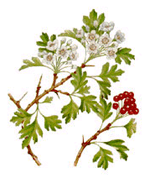
Hawthorn
Introduction
This fact sheet provides basic information about hawthorn-common names, uses, potential side effects, and resources for more information. Hawthorn is a spiny, flowering shrub or small tree of the rose family. The species of hawthorn discussed here are native to northern European regions and grow throughout the world.Common Names
hawthorn, English hawthorn, harthorne, haw, hawthorneLatin Names
Crataegus laevigata (also known as Crataegus oxyacantha), Crataegus monogynaWhat It Is Used For
- Hawthorn fruit has been used for heart disease since the first century. It has also been used for digestive and kidney problems.
- More recently, hawthorn leaf and flower have been used for heart failure, a weakness of the heart muscle that prevents the heart from pumping enough blood to the rest of the body, which can lead to fatigue and limit physical activities.
- Hawthorn is also used for other heart conditions, including symptoms of coronary artery disease (such as angina).
How It Is Used
The hawthorn leaf and flower are used to make liquid extracts, usually with water and alcohol. Dry extracts can be put into capsules and tablets.What the Science Says
- There is scientific evidence that hawthorn leaf and flower are safe and effective for milder forms of heart failure.
- There is not enough scientific evidence to determine whether hawthorn works for other heart problems.
- NCCAM-supported research to date includes a study of the mechanism by which hawthorn may affect heart failure.
Side Effects and Cautions
- Hawthorn is considered safe for most adults when used for short periods of time. Side effects are usually mild and can include upset stomach, headache, and dizziness.
- Drug interactions with hawthorn have not been thoroughly studied. It was once thought that hawthorn interacted with the heart medicine digoxin. However, a very small study in people without heart conditions found no interaction, but evidence is limited.
- Tell your health care providers about any complementary and alternative practices you use. Give them a full picture of what you do to manage your health. This will help ensure coordinated and safe care. Top
Sources
- Busse WR, Juretzek W, Koch E. Hawthorn (Crataegus). In: Coates P, Blackman M, Cragg G, et al., eds. Encyclopedia of Dietary Supplements. New York, NY: Marcel Dekker; 2005:337-347.
- De Smet PA. Herbal Remedies. The New England Journal of Medicine.
- Hawthorn. Natural Medicines Comprehensive Database Web site. Accessed on July 5, 2007.
- Hawthorn (Crataegus laevigata, C. oxyacantha, C. monogyna, C. penagyna). Natural Standard Database Web site. Accessed on July 3, 2007.
- Hawthorn. In: Blumenthal M, Goldberg A, Brinckman J, eds. Herbal Medicine: Expanded Commission E Monographs. Newton, MA: Lippincott Williams & Wilkins; 2000:182-191.
- NCCAM National Institutes of Health






